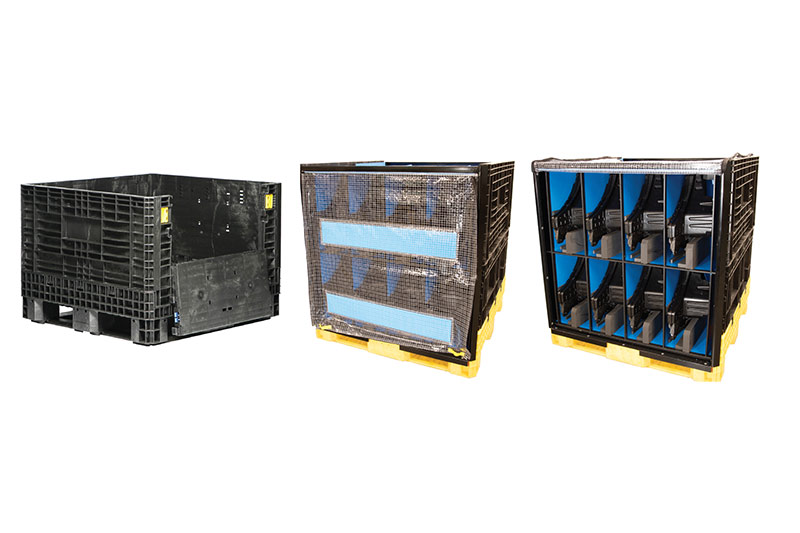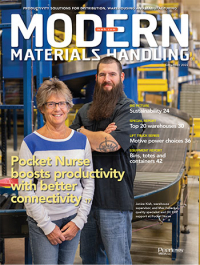Protecting those special-finish, highly visible parts
A customized bulk container design prevents scratches and more on its way from the dock to lineside assembly.

Let me count the ways that a special-finish, highly visible part can get scratched, abraded or otherwise marred, rendering it unusable:
- rough lift truck handling of bulk containers loaded with these parts,
- careless handling at the shipping dock,
- uneven highway travel,
- more rough handling at the receiving dock, and
- hapless handling when delivered lineside for final assembly.
That’s five obvious opportunities with, in all likelihood, others lurking in the shadows.
Whatchyagonnado?
Mark Ward, business development manager at Schaefer Plastics North America, has a suggestion. He calls it the Guardian. Seems like an appropriate name, actually.
What he’s talking about is a somewhat deconstructed standard plastic bulk container. One or two plastic walls are removed and a steel frame is put around the container to maintain its structural integrity. Meanwhile, various structures or cells are added into the container to individually hold and protect those sensitive parts. If you’re having trouble envisioning this (yes, I had trouble, too), check out the photos below.
The most interesting recent application for the Guardian, says Ward, is shipment of high-end speakers for a line of luxury cars. Each speaker is each loaded into its own cell (16 total in the container) and protected from touching each other and any other surfaces during storage and transport.
But there’s still another angle here. The speakers are loaded from either side into their cells in a particular orientation. When they arrive lineside, assembly workers simply reach into a cell, remove the part and install it in the car without any change in orientation. Can’t do much more than protect the part and make it so easily accessible for speedy assembly.
Sounds easy enough, but this custom bulk container didn’t just happen. Ward says it took several iterations and extensive vibration testing to ensure the parts would arrive unscathed. Fortunately, mission accomplished.
And he says this isn’t the first time the Guardian design has solved a tough bulk packaging problem. Ward says three key objectives are important when working through designs that range from rigid cells to hanging bags.
First is to protect the part from damage.
Second is getting as many parts as possible into the container. “The idea here,” says Ward, “is to fully load each container and get as many parts as possible onto each truckload. That saves fuel and minimizes trips to move thousands and thousands of parts. The end result is a reduced carbon footprint.”
The third objective is to do all this as economically as possible. But it’s worth noting that this is economy as defined by ensuring all parts are protected.
By the way, there’s a protection-of-the-environment benefit here beyond what was mentioned in point two.
Ward explains that SSI Schaefer has a program that takes back bulk containers, as well as totes and bins, from users once the useful life has been reached. SSI Schaefer credits users on future purchases the going rate for recycled plastic from those containers and then recycles the plastic for reuse. Not a bad program.

Article Topics
Packaging News & Resources
Pack Expo East has largest show to date The Paccurate Report How AI just made label placement better Record-breaking Pack Expo Las Vegas exceeds expectations Optimal Parcel Packing For Cost Automated packaging makes noise at Crutchfield Packaging Issue: Positive results are front and center More PackagingLatest in Materials Handling
Materials Handling Robotics: The new world of heterogeneous robotic integration Lucas Watson appointed CSO for Körber’s Parcel Logistics business in North America Hyster recognizes Dealers of Distinction for 2023 Carolina Handling names Joe Perkins as COO C-suite Interview with Keith Moore, CEO, AutoScheduler.AI: MODEX was a meeting place for innovation Walmart deploying autonomous lift trucks at four of its high-tech DCs Coles shops big for automation More Materials HandlingAbout the Author
Subscribe to Materials Handling Magazine

Find out what the world's most innovative companies are doing to improve productivity in their plants and distribution centers.
Start your FREE subscription today.
April 2024 Modern Materials Handling

Latest Resources











